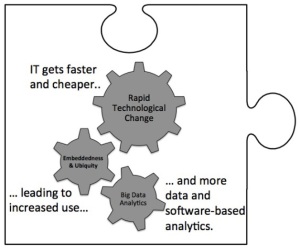In a working paper that will be presented in a few months at the HICSS conference, I describe how leveraging technology trajectories is one of four principles of Digital Fitness. Digital fitness is how I refer to the digital capabilities and mindsets required of all organizational leaders in order to succeed in today’s chaotic digitally enabled business world.
Leveraging technology trajectories is encapsulated by the moving gears in the illustration below. IT continues to get faster, smaller, and cheaper. This leads to increasing and innovative uses to substitute away from older methods or complement existing ones. This ultimately leads to the data avalanche facing most large companies and the use of analytics and other creative software approaches to convert it into value.
Source: Melville, N.P. “Digital Fitness: Four Principles for Successful Development of Digital Initiatives,” paper accepted to HICSS-48, January 5-8, 2015.
A good example of leveraging technology trajectories in the environmental sustainability space is provided in a post on SustainableBrands by Paul Bosworth, which summarizes the critical role that data plays in driving sustainability at USPS:
Data, Data, Data
Sustainable business these days requires data, and lots of it. Companies are using sustainability data for a multiplicity of reasons: to inform corporate strategy, comply with regulations, evaluate investments, improve transparency, develop products and processes, manage risk, benchmark themselves against competitors, change organisational culture, and engage with supply chains.
Increasingly, companies that take a well-organised and data-driven approach are more likely to see investments in their sustainability programme pay off. This means using analysis to better inform decision making, leading to methodically prioritised initiatives that get off the ground far more quickly.
Once the data management programme begins to mature and data inputs are integrated that reach across a company’s financial planning databases and other operational information resources, opportunities for cost savings and revenue generation can be routinely identified and acted upon.
Driving Value From Data
My favourite example of an organisation using data to drive sustainable development is the United States Postal Service (USPS). Across 32,000 facilities, their Office of Sustainability designed an employee-led programme to address goals in waste reduction, energy conservation, fleet fuel reduction, consumables spending, recycling, and water use.
To aggregate and display relevant data, USPS developed a Green Initiatives Tracking Tool (GITT). This features dashboards that allow cost efficiencies and performance enhancements to be monitored across the organisation. The GITT system achieves this by providing status updates for core projects, as well as financial information, through direct connection with the accounting system for each facility.
GITT is also designed to be interactive. It includes a start-up list of 41 suggested projects for facilities as well as guidelines and training modules for their completion. Managers can also understand clearly what projects are in place and where via sustainability performance metrics that are triggered upon project implementation. Ready access to GITT information and comparative tables enable comparison between facilities and geographies. Most importantly, USPS can now track progress in real time at a national level and support those facilities that need additional help.
By using data aggregation and analytics, USPS was able to gain visibility into its progress on sustainability and isolate over $52m in savings in 2012 largely due to employee-led initiatives.
Unfortunately, as I argue in the article, too many digital initiatives fail to meet expectations. It’s my hypothesis that the lack of digital fitness is one source of these high rates of failure. If this is true, it would be interesting to refine the concept of digital fitness by studying leaders at companies that seem to excel at the intersection of IT and corporate environmental sustainability, including SAP, IBM, Danone, Intel, Nest, OPower, and Ebay. What might we learn?

